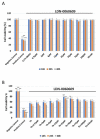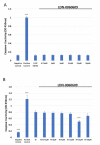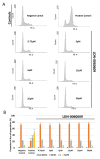Evaluation of the LDN-0060609 PERK Inhibitor as a Selective Treatment for Primary Open-Angle Glaucoma: An In Vitro Study on Human Retinal Astrocytes
- PMID: 38255802
- PMCID: PMC10815359
- DOI: 10.3390/ijms25020728
Evaluation of the LDN-0060609 PERK Inhibitor as a Selective Treatment for Primary Open-Angle Glaucoma: An In Vitro Study on Human Retinal Astrocytes
Abstract
The term glaucoma encompasses various neurodegenerative eye disorders, among which the most common is primary open-angle glaucoma (POAG). Recently, the essential role of human retinal astrocytes (HRA) in glaucoma progression has been placed in the spotlight. It has been found that placing the endoplasmic reticulum (ER) under stress and activating PERK leads to apoptosis of HRA cells, which inhibits their neuroprotective effect in the course of glaucoma. Therefore, the aim of the present study was to evaluate the effectiveness of the small-molecule PERK inhibitor LDN-0060609 in countering ER stress conditions induced in HRA cells in vitro. The activity of LDN-0060609 was studied in terms of protein and mRNA expression, cytotoxicity, genotoxicity, caspase-3 level and cell cycle progression. LDN-0060609 at 25 μM proved to be a potent inhibitor of the major PERK substrate, p-eIF2α (49% inhibition). The compound markedly decreased the expression of pro-apoptotic ER stress-related genes (ATF4, DDIT3, BAX and Bcl-2). Treatment with LDN-0060609 significantly increased cell viability, decreased genotoxicity and caspase-3 levels, and restored cell cycle distribution in HRA cells with activated ER stress conditions. These findings indicate that the small-molecule PERK inhibitor LDN-0060609 can potentially be developed into a novel anti-glaucoma agent.
Keywords: PERK; PERK inhibitor; eIF2α; endoplasmic reticulum stress; glaucoma; glaucoma treatment; unfolded protein response.
Conflict of interest statement
The authors declare no conflicts of interest.
Figures








Similar articles
-
The Potential Role of Small-Molecule PERK Inhibitor LDN-0060609 in Primary Open-Angle Glaucoma Treatment.Int J Mol Sci. 2021 Apr 26;22(9):4494. doi: 10.3390/ijms22094494. Int J Mol Sci. 2021. PMID: 33925820 Free PMC article.
-
[Niskocząsteczkowe inhibitory szlaku adaptacyjnej odpowiedzi na stres zależnego od kinazy PERK jako nowatorska strategia terapeutyczna w leczeniu choroby Alzheimera].Pol Merkur Lekarski. 2019 Jan 28;46(271):9-15. Pol Merkur Lekarski. 2019. PMID: 30810108 Polish.
-
Resveratrol‑mediated activation of SIRT1 inhibits the PERK‑eIF2α‑ATF4 pathway and mitigates bupivacaine‑induced neurotoxicity in PC12 cells.Exp Ther Med. 2023 Jul 24;26(3):433. doi: 10.3892/etm.2023.12132. eCollection 2023 Sep. Exp Ther Med. 2023. PMID: 37602306 Free PMC article.
-
The Role of the PERK/eIF2α/ATF4/CHOP Signaling Pathway in Tumor Progression During Endoplasmic Reticulum Stress.Curr Mol Med. 2016;16(6):533-44. doi: 10.2174/1566524016666160523143937. Curr Mol Med. 2016. PMID: 27211800 Free PMC article. Review.
-
The Genetic and Endoplasmic Reticulum-Mediated Molecular Mechanisms of Primary Open-Angle Glaucoma.Int J Mol Sci. 2020 Jun 11;21(11):4171. doi: 10.3390/ijms21114171. Int J Mol Sci. 2020. PMID: 32545285 Free PMC article. Review.
Cited by
-
Gene Expression Profiling to Unfolded Proteins Response as a Risk Modulator of Patients with Rheumatoid Arthritis.Int J Mol Sci. 2024 Apr 29;25(9):4854. doi: 10.3390/ijms25094854. Int J Mol Sci. 2024. PMID: 38732072 Free PMC article.
References
-
- Burton M.J., Ramke J., Marques A.P., Bourne R.R.A., Congdon N., Jones I., Ah Tong B.A.M., Arunga S., Bachani D., Bascaran C., et al. The Lancet Global Health Commission on Global Eye Health: Vision beyond 2020. Lancet Glob. Health. 2021;9:e489–e551. doi: 10.1016/S2214-109X(20)30488-5. - DOI - PMC - PubMed
MeSH terms
Substances
Grants and funding
LinkOut - more resources
Full Text Sources
Medical
Research Materials

